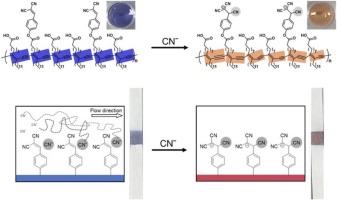A polydiacetylene (PDA)-based colorimetric sensor for on-site cyanide anion monitoring integrated with a lateral flow assay platform
IF 8
1区 化学
Q1 CHEMISTRY, ANALYTICAL
引用次数: 0
Abstract
An advanced sensing platform for the on-site and real-time monitoring of cyanide (CN−) pollution was developed, addressing the key challenges of enhancing the selectivity and sensitivity, whilst simplifying the sensing process. This platform features a novel colorimetric sensor (PDA-BMN) created by incorporating a receptor for CN− recognition within a polydiacetylene (PDA) conjugated polymer system. The interaction of CN− with the receptor distorted the π-conjugated backbone, causing a distinct color change from blue to orange, with a limit of detection (LOD) of 0.55 µM, thereby highlighting its high sensitivity. The PDA-BMN system was integrated into a lateral flow assay (LFA) strip to facilitate on-site monitoring. The LFA strip was strategically designed with a partially pressed zone to reduce the fluid flow rate, enhance the reaction time, and increase the probability of interaction with the PDA-BMN sensor. This innovation resulted in a significant colorimetric transition, enabling the rapid and sensitive detection of CN− without the requirement for analytical instruments. This study demonstrates the effectiveness of combining PDA and LFA systems for real-time environmental monitoring, offering a robust, efficient, and user-friendly solution for detecting CN− pollution.

基于聚二乙炔 (PDA) 的比色传感器,用于现场氰化阴离子监测,并与侧向流分析平台集成
我们开发了一种用于现场和实时监测氰化物(CN-)污染的先进传感平台,解决了在简化传感过程的同时提高选择性和灵敏度的关键难题。该平台采用了一种新型比色传感器(PDA-BMN),通过在聚二乙炔(PDA)共轭聚合物系统中加入识别 CN- 的受体而形成。CN- 与受体的相互作用使 π 共轭骨架变形,导致颜色从蓝色明显变为橙色,检测限 (LOD) 为 0.66 µM,从而突出了其高灵敏度。PDA-BMN 系统集成在横向流动检测条(LFA)中,便于现场监测。LFA 试剂条在设计上采用了部分压区的策略,以降低流体流速、延长反应时间并增加与 PDA-BMN 传感器相互作用的概率。这一创新带来了显著的比色转换,从而无需分析仪器即可快速灵敏地检测 CN-。这项研究证明了结合 PDA 和 LFA 系统进行实时环境监测的有效性,为检测 CN- 污染提供了一种稳健、高效和用户友好的解决方案。
本文章由计算机程序翻译,如有差异,请以英文原文为准。
求助全文
约1分钟内获得全文
求助全文
来源期刊

Sensors and Actuators B: Chemical
工程技术-电化学
CiteScore
14.60
自引率
11.90%
发文量
1776
审稿时长
3.2 months
期刊介绍:
Sensors & Actuators, B: Chemical is an international journal focused on the research and development of chemical transducers. It covers chemical sensors and biosensors, chemical actuators, and analytical microsystems. The journal is interdisciplinary, aiming to publish original works showcasing substantial advancements beyond the current state of the art in these fields, with practical applicability to solving meaningful analytical problems. Review articles are accepted by invitation from an Editor of the journal.
 求助内容:
求助内容: 应助结果提醒方式:
应助结果提醒方式:


